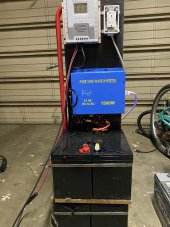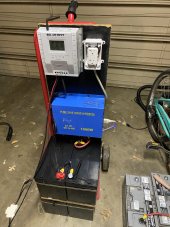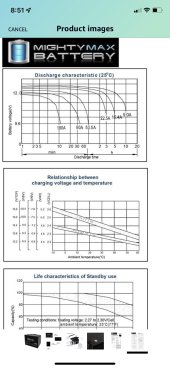I have a question for you guys: how efficient are your panels? I’m trying to figure if my charge controller, wiring or panels are the culprit for a 65% efficiency. I’m weary about shorting the panels to measure amps. I’ve heard you should only do this below 50 volts. I’m @ 80 volts. Advice?
I think I read most of this thread, hoe I am not repeating too much, there are some really smart people already on this thread.
At solar noon sun, I am hitting over 240 watts from my 300 watt panels, and that is the output of the Enphase inverters, but they are claimed to be 97% efficient. So I would think a panel that is getting decent sun with good tilt angle should be able to hit 80% of it's STC power rating, depending on where you live though. Haze in the sky can knock the output down a bit more. A few days ago, all 16 of my panels were well over the 80% (240 watt) mark, but today, it looked just as sunny, but I only hit 230 watts on the best panels, a few were down to 220 watts. The air was hotter and less wind, so the solar panels also got hotter in the sun.
If you want to do the VOC and ISC tests on your solar panels I would only do it one panel at a time. Not only is it a lot safer when you open the short, it will also let you see if you have a weak panel as you can compare them all separately. Ideally, you want the open voltage and the shorted current of all the panels to match and be at least 80% of the ratings on the panels. If you are running the panels in series, just one weak panel will drop the output of the entire string.
Have you looked up how many "sun hours" you should be getting at your location and with your panel tilt and heading angles? I saw you said "6 good hours of sun" but it does not really work like that. Sun hours is the total equivalent sun you get in the entire day of sun. Today, I was getting some power from my solar panels for 11.5 hours, to get that 5.4 sun hours of energy. The power starts very low at sunrise, climbs to the peak close to panel rating at solar noon, and then drops back down to zero again at sunset. I use this site to get a decent estimate of sun hours.

www.solarelectricityhandbook.com
Go to the bottom left of the page and click on the arrow under "Solar Irradiance Tables". It will give you a rough idea of the sun hours you should be able to get on a clear day each month. Closer to winter, the numbers drop, and closer to summer the numbers are better, the table give the average for each month. I get 15% more at the end of March compared to the beginning of March as the days are getting longer. I was getting about 5.4 sun hours a day this past week, but I am in sunny SO Cal. If your 1,320 watts of solar panel were here, they should produce about 7.1 kwh a day, if they were turned 20 degrees west, and 20 degrees up from flat towards the equator. That is the position of my array, at 32 degrees north latitude.
To make use of the panels you have, you do need a lot more battery. You solar panels should be able to make 130 amps hours or so in a 48 volts system. So with AGM you should have close to 300 amp hours to make them last. If you can really put 7 kwh into your car at a more realistic 4 miles per kwh, then you might get 28 miles of range per day. A bit less in winter, and maybe a little more in summer.







